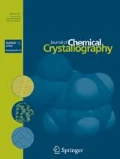Abstract
2,2′-Bipyridine-4-methyl-3,3′-dicarboxylic acid monohydrate (1) is introduced as a new organic ligand. Synthesis, structure and properties (TGA, IR, NMR) are characterized. 1 includes an extensive hydrogen bonding network with formation of various graph-set motifs, such as \( {\text{R}}_{2}^{2} \left( { 1 8} \right) \) or \( {\text{R}}_{12}^{10} \left( { 40} \right) \). In contrast to the related compounds, 1 does not participate in formation of MOFs. This is rationalized based on DFT calculations showing that the most plausible conformations of 1 do not favour coordination of a metal ion.
Graphical Abstract
2,2′-bipyridine-4-methyl-3,3′-dicarboxylic acid monohydrate is introduced as a new organic ligand and its inability to form MOFs is explained based on DFT calculations.




References
Beves JE, Constable EC, Housecroft CE, Neuburger M, Schaffner S (2008) CrystEngComm 10:344
Constable EC, Zhang G, Housecroft CE, Zampese JA (2011) CrystEngComm 13:6864
Dawid U, Pruchnik FP, Starosta R (2009) Dalton Trans 17:3348
Dholakia S, Gillard RD, Wimmer FL (1985) Polyhedron 4:791
Inglett GE, Smith GF (1950) J Am Chem Soc 72:842
Ji B, Deng D, He X, Liu B, Miao S, Ma N, Wang W, Ji L, Liu P, Li X (2012) Inorg Chem 51:2170
Kochel A, Hołyńska M, Twaróg K (2012) Inorg Chem Commun 24:47
Kochel A, Hołyńska M (2013) Inorg Chim Acta 408:193
CrysAlisPro, Agilent Technoliges (2011) Version 1.171.35.19
Sheldrick GM (1997) SHELXTL 5.1, Bruker AXS Inc., Madison
Pennington WT (1999) J Appl Cryst 32:1028
Becke AD (1993) J Chem Phys 98:5648
Lee C, Yang W, Parr RG (1988) Phys Rev B 37:785
Frisch MJ, Trucks GW, Schlegel HB, Scuseria GE, Robb MA, Cheeseman JR, Montgomery JA Jr, Vreven T, Kudin KN, Burant JC, et al (2004) Gaussian 03, revision B.03; Gaussian, Inc., Wallingford
Etter MC, MacDonald JC, Bernstein J (1990) Acta Cryst B46:256
Ioth K, Bermstein HJ (1956) Can J Chem 34:170
Nakamoto K (1997) Infrared and Raman Spectra of inorganic and coordination compounds, 5th edn. Wiley, New York
Kapota C, Lemaire J, Maître P, Ohanessian G (2004) J Am Chem Soc 126:1836
Polfer NC, Paizs B, Snoek LC, Compagnon I, Suhai S, Meijer G, von Helden G, Oomens J (2005) J Am Chem Soc 127:8571
Acknowledgments
Help of Prof. Dr. S. Dehnen (generous support), Z. Marchewka (IR spectra) and J. Wojaczyński (NMR spectra) is gratefully acknowledged.
Author information
Authors and Affiliations
Corresponding authors
Electronic supplementary material
Below is the link to the electronic supplementary material.
Rights and permissions
About this article
Cite this article
Hołyńska, M., Filarowski, A., Kochel, A. et al. Why Does the 2,2′-Bipyridine-4-methyl-3,3′-Dicarboxylic Acid Not Form MOFs: Synthesis, Crystal Structure and Properties of a New Organic Ligand. J Chem Crystallogr 45, 363–368 (2015). https://doi.org/10.1007/s10870-015-0591-1
Received:
Accepted:
Published:
Issue Date:
DOI: https://doi.org/10.1007/s10870-015-0591-1

